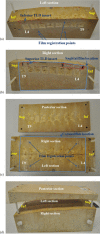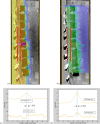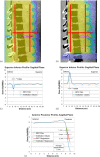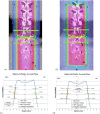An anthropomorphic spine phantom for proton beam approval in NCI-funded trials
- PMID: 24892351
- PMCID: PMC5711048
- DOI: 10.1120/jacmp.v15i3.4742
An anthropomorphic spine phantom for proton beam approval in NCI-funded trials
Abstract
As part of the approval process for the use of scattered or uniform scanning proton therapy in National Cancer Institute (NCI)-sponsored clinical trials, the Radiological Physics Center (RPC) mandates irradiation of two RPC anthropomorphic proton phantoms (prostate and spine). The RPC evaluates these irradiations to ensure that they agree with the institutions' treatment plans within criteria of the NCI-funded cooperative study groups. The purpose of this study was to evaluate the use of an anthropomorphic spine phantom for proton matched-field irradiation, and to assess its use as a credentialing tool for proton therapy beams. We used an anthropomorphic spine phantom made of human vertebral bodies embedded in a tissue substitute material called Muscle Substitute/Solid Rigid Number 4 (MS/SR4) comprising three sections: a posterior section containing the posterior surface and the spinous processes, and left and right (L/R) sections containing the vertebral bodies and the transverse processes. After feasibility studies at three institutions, the phantom, containing two thermoluminescent dosimeters (TLDs) for absolute dose measurements and two sheets of radiochromic film for relative dosimetry, was shipped consecutively to eight proton therapy centers participating in the approval study. At each center, the phantom was placed in a supine or prone position (according to the institution's spine treatment protocol) and imaged with computed tomography (CT). The images then were used with the institution's treatment planning system (TPS) to generate two matched fields, and the phantom was irradiated accordingly. The irradiated phantom was shipped to the RPC for analysis, and the measured values were compared with the institution's TPS dose and profiles using criteria of ± 7% for dose agreement and 5 mm for profile distance to agreement. All proton centers passed the dose criterion with a mean agreement of 3% (maximum observed agreement, 7%). One center failed the profile distance-to-agreement criterion on its initial irradiation, but its second irradiation passed the criterion. Another center failed the profile distance-to-agreement criterion, but no repeat irradiation was performed. Thus, seven of the eight institutions passed the film profile distance-to-agreement criterion with a mean agreement of 1.2 mm (maximum observed agreement 5 mm). We conclude that an anthropomorphic spine phantom using TLD and radiochromic film adequately verified dose delivery and field placement for matched-field treatments.
Figures






Similar articles
-
Results From the Imaging and Radiation Oncology Core Houston's Anthropomorphic Phantoms Used for Proton Therapy Clinical Trial Credentialing.Int J Radiat Oncol Biol Phys. 2016 May 1;95(1):242-248. doi: 10.1016/j.ijrobp.2016.01.061. Epub 2016 Feb 10. Int J Radiat Oncol Biol Phys. 2016. PMID: 27084644 Free PMC article.
-
MO-D-BRB-04: The Approval Process for the Use of Proton Therapy in NCI-Sponsored Clinical Trials.Med Phys. 2012 Jun;39(6Part21):3866. doi: 10.1118/1.4735785. Med Phys. 2012. PMID: 28518264
-
Design, development, and implementation of the radiological physics center's pelvis and thorax anthropomorphic quality assurance phantoms.Med Phys. 2007 Jun;34(6):2070-6. doi: 10.1118/1.2737158. Med Phys. 2007. PMID: 17654910
-
Quality assurance for clinical trials.Front Oncol. 2013 Dec 19;3:311. doi: 10.3389/fonc.2013.00311. Front Oncol. 2013. PMID: 24392352 Free PMC article. Review.
-
Advances and Challenges in Conducting Clinical Trials With Proton Beam Therapy.Semin Radiat Oncol. 2023 Oct;33(4):407-415. doi: 10.1016/j.semradonc.2023.06.006. Semin Radiat Oncol. 2023. PMID: 37684070 Free PMC article. Review.
Cited by
-
Commissioning and initial experience with the first clinical gantry-mounted proton therapy system.J Appl Clin Med Phys. 2016 Mar 8;17(2):24-40. doi: 10.1120/jacmp.v17i2.5868. J Appl Clin Med Phys. 2016. PMID: 27074470 Free PMC article.
References
-
- New guidelines for the use of proton radiation therapy in NCI‐sponsored cooperative group clinical trials [RPC Webpage Newsletter] . RPC. 2012;11(1). May 2012. Retrieved on July 1, 2013 from http://rpc.mdanderson.org/RPC/home.htm
-
- Followill DS, Evans DR, Cherry C, et al. Design, development, and implementation of the radiological physics center's pelvis and thorax anthropomorphic quality assurance phantoms. Med Phys. 2007;34(6):2070–76. - PubMed
-
- Dominiak GS. Dose in spinal cord following electron irradiation [MA thesis]. The University of Texas Health Science Center at Houston, Graduate School of Biomedical Sciences; 1991.
-
- Constantinou C. Tissue substitutes for particulate radiations and their use in radiation dosimetry and radiotherapy [PhD thesis]. University of London; 1978.
-
- Constantinou C, Kember NF, Huxtable G, Whitehead C, Stedeford JB, Weatherburn H. Physical measurements with a high‐energy proton beam using liquid and solid tissue substitutes. Phys Med Biol. 1980;25(3):489–99. - PubMed
Publication types
MeSH terms
Substances
Grants and funding
LinkOut - more resources
Full Text Sources
Other Literature Sources
Medical
Research Materials

